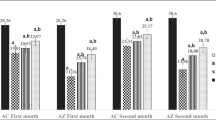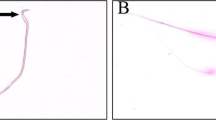Abstract
The effects of the fungicide methyl thiophanate (MT) on testis were determined in the Italian wall lizard (Podarcis sicula) using morphological and molecular analyzes. Three experimental trials were performed: an acute test using six doses, a two-week chronic test, and “ecotoxicological” exposure (3 weeks). The minimal lethal dose (LD50) of pure MT, reached by the acute test, was 100 mg/kg body weight. Testicular histopathology of surviving animals showed a reduced lumen and several multinucleated giant cells 24 h after injection followed by large decreases in spermatogonia (72%) and secondary spermatocytes (58%) and a loss of spermatids and sperms 7 days after. In the chronic test, a dose equivalent to 1/100 of LD50 was injected on alternate days. Complete shutting of the lumen and a great decrease in spermatogonia (82%) were observed. In “ecotoxicological” exposure, achieved with a commercial MT compound, testis showed a decrease in primary spermatocytes (20%) and several vacuoles. An increase in germ cell apoptosis was observed in all experimental groups using TUNEL assay. A decrease in expression of androgen and estrogen receptor (AR and ER) mRNAs was seen in all experimental groups. The reduction in AR and ER mRNAs was correlated to exposure time. Indeed, in the “ecotoxicological” treatment (30 days), the decrease reached 82 and 90% for AR and ER mRNAs, respectively. These data strongly indicate that treatment with MT, damaging the seminiferous epithelium and decreasing steroid receptor expression, might render exposed lizards infertile.






Similar content being viewed by others
References
Abercrombie M (1946) Estimation of nuclear population from microtome sections. Anat Rec 94:239–247
Abney TO (1999) The potential roles of estrogens in regulating Leydig cell development and function: a review. Steroids 64:610–617
Aire TA (2005) Short-term effects of carbendazim on the gross and microscopic features of the testes of Japanese quails (Coturnix coturnix japonica). Anat Embryol 210:43–49
Angelini F, Botte V (1992) Spermatogenesis in reptiles, dynamic and regulatory aspect. In: Dallai R (ed) Sex origin and evolution. Mucchi Selected Symposia and Monographs UZI, Modena, pp 211–230
Bernanke J, Köhler HR (2009) The impact of environmental chemicals on wildlife vertebrates. Rev Environ Contam Toxicol 198:1–47
Bologna MA, Capula M, Carpaneto GM (2000) Anfibi e Rettili del Lazio. Palombi, Rome
Bryan AM, Olafsson PG, Stone WB (1987) Disposition of low and high environmental concentrations of PCBs in snapping turtle tissues. Bull Environ Contam Toxicol 38:1000–1005
Cardone A, Angelini F, Varriale B (1998) Autoregulation of estrogen and androgen receptor mRNAs and downregulation of androgen receptor mRNA by estrogen in primary cultures of lizard testis cells. Gen Comp Endocrinol 110:227–236
Cardone A, Comitato R, Bellini L, Angelini F (2002) Effects of the aromatase inhibitor Fadrozole on plasma sex steroid secretion and spermatogenesis, and epididymis morphology in the lizard, Podarcis sicula. Mol Reprod Dev 63:63–70
Cardone A, Comitato R, Angelini F (2008) Spermatogenesis, epididymis morphology and plasma sex steroid secretion in the male lizard Podarcis sicula exposed to diuron. Environ Res 108:214–223
Carter SD, Hess RA, Laskey JW (1987) The fungicide methyl 2-benzimidazole carbamate causes infertility in male Sprague-Dawley rats. Biol Reprod 37:709–717
Clermont Y, Morgentaler H (1955) Quantitative study of spermatogenesis in hypophysectomized rats. Endocrinol 57:369–382
Comitato R, Esposito T, Cerbo G, Angelini F, Varriale B, Cardone A (2006) Impairment of spermatogenesis and enhancement of testicular germ cell apoptosis induced by exogenous all trans-retinoic acid in adult lizard Podarcis sicula. J Exp Zool 305A:288–298
Correa LM, Nakai M, Strandgaard CS, Hess RA, Miller MG (2002) Microtubules of the mouse testis exhibit differential sensitivity to the microtubule disruptors carbendazim and colchicine. Toxicol Sci 69:175–182
Creasy DM (2001) Pathogenesis of male reproductive toxicity. Toxicol Pathol 29:64–76
Cummings AM, Harris ST, Rehnberg GL (1990) Effects of methyl benzimidazole-carbamate during early pregnancy in the rat. Fundam Appl Toxicol 15:528–535
Davidse LCA, Flach W (1977) Differential binding of methyl benzimidazol-2-yl carbamate to fungal tubulin as a mechanism of resistance to this antimitotic agent in mutant strains of Aspergillus nidulans. J Cell Biol 72:174–193
De Falco M, Sciarrillo R, Capaldo A, Russo T, Gay F, Valiante S, Varano L, Laforgia V (2007) The effects of the fungicide methyl thiophanate on adrenal gland morphophysiology of the lizard, Podarcis sicula. Arch Environ Contam Toxicol 53:241–248
De Gendt K, Swinnen JV, Saunders PT, Schoonjans L, Dewerchin M, Devos A, Tan K, Atanassova N, Claessens F, Lecureuil C, Heyns W, Carmeliet P, Guillou F, Sharpe RM, Verhoeven G (2004) A Sertoli cell-selective knockout of the androgen receptor causes spermatogenic arrest in meiosis. Proc Natl Acad Sci U S A 101:1327–1332
Fimognari C, Nusse M, Hrelia P (1999) Flow cytometric analysis of genetic damage, effect on cell cycle progression, and apoptosis by thiophanate-methyl in human lymphocytes. Environ Mol Mutagen 33:173–176
Fuchs A, Van Der Berg GA, Davidse LCA (1972) Comparison of benomyl and thiophanates with respect to some chemical and systemic fungitoxic characteristics. Pest Biochem Physiol 2:191–205
Gibbons JW, Scout DE, Ryan TJ, Buhlmann KA, Tuberville TD, Metts BS, Greene JL, Mills T, Leiden Y, Popy S, Winne CT (2000) The global decline of reptiles, deja vu amphibians. Bioscience 50:653–666
Gray LE, Ostby J, Linder R, Goldman J, Rehnberg G, Cooper R (1990) Carbendazim-induced alterations of reproductive development and function in the rat and hamster. Fundam Appl Toxicol 15:281–297
Greenberg N, Wingfield JC (1987) Stress and reproduction: reciprocal relationships. In: Norris DO, Jones RE (eds) Hormones and reproduction in fishes, amphibians and reptiles. Plenum Press, New York, pp 461–503
Hall RJ, Clark DR Jr (1982) Responses of the iguanid lizard Anolis carolinensis to four organophosphorus pesticides. Environ Pollut 28:45–52
Hayes WJ Jr, Laws ER Jr (1991) Handbook of pesticide toxicology, vol. 3, classes of pesticides. Academic Press, New York
Hess RA, Nakai M (2000) Histopathology of the male reproductive system induced by the fungicide benomyl. Histol Histopathol 15:207–224
Hewitson TD, Darby IA (2010) In situ localization of apoptosis using TUNEL. Methods Mol Biol 611:161–170
Hopkins WA (2000) Reptile toxicology: challenges and opportunities on the last frontier in vertebrate ecotoxicology. Environ Toxicol Chem 19:2391–2393
Lim J, Miller MG (1997) The role of the benomyl metabolite carbendazim in benomyl-induced testicular toxicity. Toxicol Appl Pharmacol 142:401–410
Lu SY, Liao JW, Kuo ML, Wang SC, Hwang JS, Ueng TH (2004) Endocrine disrupting activity in carbendazim-induced reproductive and developmental toxicity in rats. J Toxicol Environ Health 67:1501–1515
Maranghi F, Macrì C, Ricciardi C, Stazi AV, Rescia M, Mantovani A (2003) Histological and histomorphometric alterations in thyroid and adrenals of CD rat pups exposed in utero to methyl thiophanate. Reprod Toxicol 17:617–623
Marsili L, Casini S, Mori G, Ancora S, Bianchi N, D’Agostino A, Ferraro M, Fossi MC (2009) The Italian wall lizard (Podarcis sicula) as a bioindicator of oil field activity. Sci Total Environ 407:3597–3604
Moffit JS, Bryan BH, Hal SJ, Boekelheide K (2007) Dose-dependent effects of Sertoli cell toxicants 2, 5-hexanedione, carbendazim, and mono-(2-ethylhexyl) phthalate in adult rat testis. Toxicol Pathol 35:719–727
Nakai M, Miller MG, Carnes K, Hess RA (2002) Stage-specific effects of the fungicide carbendazim on Sertoli cell microtubules in rat testis. Tissue Cell 34:73–80
O’Donnell L, Robertson KM, Jones ME, Simpson ER (2001) Estrogen and spermatogenesis. Endocr Rev 22:289–318
Rathinasamy K, Panda D (2006) Suppression of microtubule dynamics by benomyl decreases tension across kinetochore pairs and induces apoptosis in cancer cells. FEBS J 273:4114–4128
Roberts TR, Hutson DH, Jewess PJ (1998) Metabolic pathways of agrochemicals: insecticides and fungicides. Royal Society of Chemistry, Great Britain
Sciarrillo R, De Falco M, Virgilio F, Laforgia V, Capaldo A, Gay F, Valiante S, Varano L (2008) Morphological and functional changes in the thyroid gland of methyl thiophanate-injected lizards, Podarcis sicula. Arch Environ Contam Toxicol 55:254–261
Smith PN, Cobb GP, Godard-Codding C, Hoff D, McMurry ST, Rainwater TR, Reynolds KD (2007) Contaminant exposure in terrestrial vertebrates. Environ Poll 150:41–64
Tabb MM, Blumberg B (2006) New modes of action for endocrine-disrupting chemicals. Mol Endocrinol 20:475–482
Traina ME, Fazzi P, Macrì C, Ricciardi C, Stazi AV, Urbani E, Mantovani A (1998) In vivo studies on possible adverse effects on reproduction of the fungicide methyl thiophanate. J Appl Toxicol 18:241–248
Walker CH, Ronis MJJ (1989) The monooxygenases of birds, reptiles and amphibians. Xenobiotica 19:1111–1121
Yu GC, Xie L, Liu YZ, Wang XF (2009) Carbendazim affects testicular development and spermatogenic function in rats. Zhonghua Nan Ke Xue 15:505–510
Acknowledgments
The author gratefully acknowledge Dr. F. Della Ragione for expert assistance with RT-qPCR analyzes and Mark Walters for linguistic revision. This study was financially supported by the Italian Ministry of Universities and Scientific and Technological Research (PRIN 2003/2005).
Author information
Authors and Affiliations
Corresponding author
Additional information
This article is dedicated to the memory of Giuseppe Falcone, an unforgettable friend who died prematurely, in recognition of his devotion to the pursuit of perfection in photography and digital art-work.
Rights and permissions
About this article
Cite this article
Cardone, A. Testicular toxicity of methyl thiophanate in the Italian wall lizard (Podarcis sicula): morphological and molecular evaluation. Ecotoxicology 21, 512–523 (2012). https://doi.org/10.1007/s10646-011-0812-0
Accepted:
Published:
Issue Date:
DOI: https://doi.org/10.1007/s10646-011-0812-0




